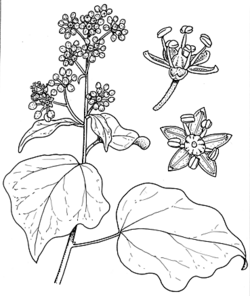Common name: English Ivy
Hedera helix L. APNI* 
Description: Woody climber to 20 m or more high or creeper, occasionally becoming shrubby with age, usually with aerial roots along the stems, glabrous or with minute stellate to peltate hairs on the younger parts.
Leaves shape and division variable, shallowly palmately 3–5-lobed, or margins entire and ± ovate, 3–10 cm long and wide, glabrous or nearly so, slightly discolorous with upper surface darker; petiole 2.5–11 cm long.
Inflorescence a panicle of umbels, with an umbel terminating each inflorescence branch. Petals 5, sometimes apically united, greenish. Styles stout, c. 1.5 mm long, persistent.
Fruit 5–10 mm diam., dull blue to black.
Flowering: Flowers chiefly summer.
Distribution and occurrence: Grows in wet sclerophyll forest or disturbed rainforest, on a variety of substrates, occasionally naturalized, usually near habitation, south from the Glen Innes district.
NSW subdivisions: *NC, *SC, *NT, *CT, *ST, *NWS
Other Australian states: *Vic.
Cultivated for its decorative (sometimes variegated) foliage and dense climbing habit. Leaves and fruit poisonous if eaten.
Text by M. J. Henwood & R. O. Makinson
Taxon concept: Flora of NSW 3 (1992)
APNI* Provides a link to the Australian Plant Name Index (hosted by the Australian National Botanic Gardens) for comprehensive bibliographic data
***The AVH map option provides a detailed interactive Australia wide distribution map drawn from collections held by all major Australian herbaria participating in the Australian Virtual Herbarium project.
|


